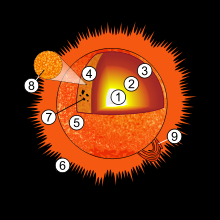(drawing by NM 3rd grade)
NEVER LOOK DIRECTLY AT THE SUN, EVEN WITH SUNGLASSES! A VERY FAMOUS ASTRONOMER WENT BLIND BY STUDYING THE SUN AND TRYING TO VIEW IT THROUGH MIRRORS! DON'T DO IT!
Questions to answer:NEVER LOOK DIRECTLY AT THE SUN, EVEN WITH SUNGLASSES! A VERY FAMOUS ASTRONOMER WENT BLIND BY STUDYING THE SUN AND TRYING TO VIEW IT THROUGH MIRRORS! DON'T DO IT!
1. Is the sun simply a giant ball of hot gases? Or does it have layers and other features?
2. Does NASA have an orbiting spacecraft around the sun?
3. Why should we study the sun? What do sunspots, solar flares, and solar prominences look like?
4. Is our sun large or small compared to other stars?
5. What are galaxies? How many stars make up a galaxy?
Lesson 1: Images
Our Sun
Parts of the Sun
(For your interactive notebook)
An illustration of the structure of the Sun:
1. Core
2. Radiative zone
3. Convective zone
4. Photosphere
5. Chromosphere
6. Corona
7. Sunspot
8. Granules
9. Prominence
1. Core
2. Radiative zone
3. Convective zone
4. Photosphere
5. Chromosphere
6. Corona
7. Sunspot
8. Granules
9. Prominence
Photographers and Astronomers can capture some of the intracacies of the sun during a total eclipse or with a special filter and lenses (image by Luc Viatour)
Do you know what the white halo is called?
Our study of the sun continues. We need exact measurements of the sun's light in order to find planets around distant stars. This machine is called a light laser. What does it use to split light?
PART 2: OTHER STARS
Stars emit different colors. We can see yellow, blue, red, orange, and of course white stars.
On a clear night you would need to 'watch' a star for some time before it has a color. Rigel is one of the blue stars we can see. Some stars have names. Others have numbers.
Stars continue to form. This dramatic scene was taken by the telescopes at the European Southern Observatory. Try and count the stars in the photo!
Part 3: Constellations and Star Fields
From early times, many cultures have put the stars together and made patterns. Many of these are still famous and we continue the tradition of using these names. These star patterns are called constellations. The International Astronomical Union recognizes 88 constellations. This beautiful star chart dates from earlier times. What can you see?
SOHO
SOHO has been sending back early warning signals to Earth since the 1990s. This spacecraft is in a very unusual part of space. It is 1 AU from the Earth and 92 AU from the sun. This is the location of an invisible part of space where Earth's gravity and the Sun's gravity are equal.
Projects....Making a Straw Rocket
Cut out and decorate all 3 parts from the NASA handout. Put your initials on one portion.
Roll the body of the rocket lengthwise around a pencil and tape in place.
Tape the fins and bend the fins in a plus sign formation.
Twist or pinch the top of the rocket and tape shut to form a 'nose'. The rocket body and nose must be airtight for good flights. Three pieces of tape along the body should be enough.
Bend the straw at the elbow for a proper angle. Do not point the rocket at other people.
A good rocket should fly at least 2 meters (about 6 feet).
Try it at different angles and record your results, both good and bad.
Use the tape marks on the carpet to determine the length of your flights.
PERSONAL LEARNING DEVICE:
We had two apps on view today. One took us on a tour of the Milky Way with animated orbits of the planets. The other located constellations in the night sky by pointing it at a direction overhead. Thanks to HP and MM for sharing. :-)
Mr. Petersen/ :-)















No comments:
Post a Comment
Thanks for stopping by our classroom website and leaving positive comments! Mr. Petersen :-)